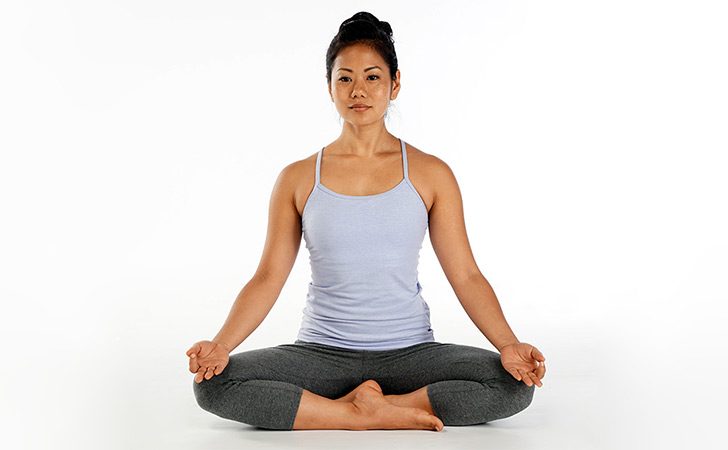Full Yogic Breath
Full Yogic Breath is a deeply balancing pranayama (breathing exercise) that benefits vata, pitta, and kapha. It is sometimes known as three-part breath because it works with three different sections of the torso and naturally engages all three lobes of the lungs.
Full Yogic Breath revitalizes the entire body with prana (essential life force). In particular, it benefits the vital organs, which can easily become stagnant, constricted, or fraught with emotional and physical tension when we experience stress.
Full Yogic Breath relieves stress, refreshes the mind, and activates the parasympathetic nervous system, encouraging a calmer, more balanced state of being overall. It also helps to correct unhealthy breathing patterns.
This pranayama can be engaged at any time, but it is especially beneficial when practiced intently for five to fifteen minutes every day—preferably on an empty stomach. The early morning is an ideal time to practice Full Yogic Breath.
Overview of the Practice
Full Yogic Breath begins with a deep and fluid inhalation that fills three sections of the torso independently, but continuously. First, we breathe into the lower abdomen. Then, we breathe into the mid-section of the torso, expanding the diaphragm and the ribs as the inhalation continues. And finally, we draw the breath into the upper chest and shoulders as the inhalation comes to a close.
This slow and purposeful inhalation is then followed by a long, slow, gentle exhale, expelling the breath from these same three sections of the torso in reverse order, releasing the upper chest, then the diaphragm and ribs, and finally the lower abdomen.
One round of Full Yogic Breath includes one complete inhalation and one complete exhalation.
Both the inhalation and the exhalation should feel fluid and continuous; at no point should either one cause any strain whatsoever.
Keep in mind that it may take some time to develop a relaxed relationship with this type of breath work, especially if it is new to you; it is no accident that pranayama is referred to as a practice. What’s important is the intention to develop our capacity for moving the breath intentionally, fluidly, and yet without tension or struggle.
Instructions for Practice
Choose a comfortable seated or lying position. If sitting, make sure that your pelvic bones are rooted into the surface beneath you, and that your spine is erect. If you prefer to lie down, lie on your back and relax your entire body, as in savasana.
Gently close your eyes and take a few moments to settle in. Close your mouth and breathe only through your nostrils. Quiet your mind, and attune to your body. Begin by simply observing the natural flow your breath. Let go of any thoughts and allow yourself to arrive completely in the present moment.
When you are ready, inhale slowly and with purpose, drawing your breath deep into the lower abdomen, starting from the pelvic floor and slowly allowing the breath to fill upward (toward the navel) and outward (away from the spine). Initially, focus only on filling the lower abdomen.
As the breath fills this area, allow it to expand outward in all directions—to the front (expanding the lower belly), to the sides (expanding the hips), and to the back (expanding the lumbar spine and the sacrum)—as it moves upward toward the navel.
Once the lower abdomen has filled completely, continue the inhalation by filling the mid-torso in a similar manner. Continue to draw the breath upwards, from the navel to the ribs, allowing the breath to gently expand the diaphragm, the ribs, and the mid-back as the breath continues to rise.
Once the mid-torso feels full, complete the inhalation by drawing the breath into the upper chest—allowing prana to rise up into the heart, the sternum, and finally into the shoulders and the base of the neck. Feel the collarbones lift slightly.
This completes the inhalation. For many, there is a brief, but natural pause at the top of the inhalation. If this occurs, just allow it to be there for a moment before surrendering to a long, slow exhalation.
First, release the breath from the upper chest as the heart, lungs, sternum and shoulders all relax—dropping down and drawing in, toward the spine. Then, expel the breath from the mid-torso, feeling the ribs contract and the navel draw in, closer to the spine. And lastly, release the breath form the lower abdomen, feeling the belly contract and draw inward toward the spine.
This completes one round of Full Yogic Breath. If your exhalation is followed by a natural pause, take a moment before beginning the next round. Then, draw a fresh inhalation into the lower abdomen.
After several rounds of Full Yogic Breath (up to fifteen minutes), allow your breathing to return to normal for a minute or two before gently opening your eyes and bringing your practice to a close. Then, before you move on to your next activity, pause briefly to notice how you feel. Are you more refreshed, awake, and relaxed? How did your practice affect or benefit you today?
As you become more comfortable with the practice of Full Yogic Breath, you can integrate this style of breathing more and more throughout your day-to-day activities.







